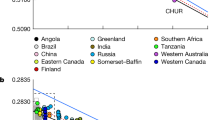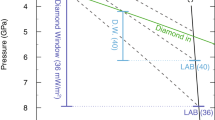Abstract
Diamonds are formed under high pressure more than 150 kilometres deep in the Earth’s mantle and are brought to the surface mainly by volcanic rocks called kimberlites. Several thousand kimberlites have been mapped on various scales1,2,3,4, but it is the distribution of kimberlites in the very old cratons (stable areas of the continental lithosphere that are more than 2.5 billion years old and 300 kilometres thick or more5) that have generated the most interest, because kimberlites from those areas are the major carriers of economically viable diamond resources. Kimberlites, which are themselves derived from depths of more than 150 kilometres, provide invaluable information on the composition of the deep subcontinental mantle lithosphere, and on melting and metasomatic processes at or near the interface with the underlying flowing mantle. Here we use plate reconstructions and tomographic images to show that the edges of the largest heterogeneities in the deepest mantle, stable for at least 200 million years and possibly for 540 million years, seem to have controlled the eruption of most Phanerozoic kimberlites. We infer that future exploration for kimberlites and their included diamonds should therefore be concentrated in continents with old cratons that once overlay these plume-generation zones at the core–mantle boundary.
This is a preview of subscription content, access via your institution
Access options
Subscribe to this journal
Receive 51 print issues and online access
$199.00 per year
only $3.90 per issue
Buy this article
- Purchase on Springer Link
- Instant access to full article PDF
Prices may be subject to local taxes which are calculated during checkout




Similar content being viewed by others
References
Jelsma, H. A. et al. Preferential distribution along transcontinental corridors of kimberlites and related rocks of southern Africa. S. Afr. J. Geol. 107, 301–324 (2004)
Kjarsgaard, B. A. in Mineral Deposits of Canada: A Synthesis of Major Deposit-Types, District Metallogeny, the Evolution of Geological Provinces, and Exploration Methods (ed. Goodfellow, W. D.) 245–272 (Geol. Assoc. Canada Special Publication 5, 2007)
Jelsma, H., Barnett, W., Richards, S. & Lister, G. Tectonic setting of kimberlites. Lithos 112, 155–165 (2009)
Heaman, L. M. & Kjarsgaard, B. A. Timing of eastern North American kimberlite magmatism: continental extension of the Great Meteor hotspot track? Earth Planet. Sci. Lett. 178, 253–268 (2000)
Jordan, T. H. in The Mantle Sample: Inclusions in Kimberlites and Other Volcanics (eds Boyd, F. R. &. Meyer, H. O. A.) 1–14 (AGU, 1979)
Mitchell, R. H. Kimberlites: Mineralogy, Geochemistry and Petrology (Plenum, 1986)
Wyllie, P. J. The origin of kimberlites. J. Geophys. Res. 85, 6902–6910 (1980)
Ringwood, A. E., Kesson, S. E., Hibberson, W. & Ware, N. Origin of kimberlites and related magmas. Earth Planet. Sci. Lett. 113, 521–538 (1992)
Haggerty, S. E. A diamond trilogy: superplumes, supercontinents, and supernovae. Science 285, 851–861 (1999)
Hayman, P. C., Kopylova, M. G. & Kaminsky, F. V. Lower mantle diamonds from Rio Soriso (Juina area, Mato Grosso, Brazil). Contrib. Mineral. Petrol. 149, 430–445 (2005)
Burke, K., Steinberger, B., Torsvik, T. H. & Smethurst, M. A. Plume generation zones at the margins of large low shear velocity provinces on the core–mantle boundary. Earth Planet. Sci. Lett. 265, 49–60 (2008)
Bryan, S. & Ernst, R. Revised definition of large igneous provinces (LIPs). Earth Sci. Rev. 86, 175–202 (2008)
Garnero, E. J., Lay, T. & McNamara, A. K. in Plates, Plumes, and Planetary Processes (eds Foulger, G. R. & Jurdy, D. M.) 79–109 (Geol. Soc. Am. Special Paper 430, 2007)
Torsvik, T. H., Smethurst, M. A., Burke, K. & Steinberger, B. Large igneous provinces generated from the margins of the large low-velocity provinces in the deep mantle. Geophys. J. Int. 167, 1447–1460 (2006)
Torsvik, T. H., Smethurst, M. A., Burke, K. & Steinberger, B. Long term stability in deep mantle structure: evidence from the ∼300 Ma Skagerrak-centered large igneous province (the SCLIP). Earth Planet. Sci. Lett. 267, 444–452 (2008)
Torsvik, T. H., Steinberger, B., Cocks, L. R. M. & Burke, K. Longitude: linking Earth’s ancient surface to its deep interior. Earth Planet. Sci. Lett. 276, 273–283 (2008)
Thorne, M. S., Garnero, E. J. & Grand, S. Geographic correlation between hot spots and deep mantle lateral shear-wave velocity gradients. Phys. Earth Planet. Inter. 146, 47–63 (2004)
Montelli, R., Nolet, G., Dahlen, F. & Masters, G. A catalogue of deep mantle plumes: new results from finite-frequency tomography. Geochem. Geophys. Geosyst. 7 Q11007 10.1029/2006GC001248 (2006)
Davaille, A., Stutzmann, E., Silveira, G., Besse, J. & Courtillot, V. Convective patterns under the Indo-Atlantic. Earth Planet. Sci. Lett. 239, 233–252 (2005)
Becker, T. W. & Boschi, L. A comparison of tomographic and geodynamic mantle models. Geochem. Geophys. Geosyst. 3 1003 10.1029/2001GC000168 (2002)
Torsvik, T. H., Müller, R. D., Van der Voo, R., Steinberger, B. & Gaina, C. Global plate motion frames: toward a unified model. Rev. Geophys. 46 RG3004 10.1029/2007RG000227 (2008)
Steinberger, B. & Torsvik, T. H. Absolute plate motions and true polar wander in the absence of hotspot tracks. Nature 452, 620–623 (2008)
Yakubchuk, A. Diamond deposits of the Siberian craton: products of post-1200 Ma plume events affecting the lithospheric keel. Ore Geol. Rev. 35, 155–163 (2009)
Kinny, P. D., Griffin, B. J., Heaman, L. M., Brakhfogel, F. F. & Spetsius, Z. V. Shrimp U–Pb ages of perovskite from Yakutian kimberlites. Russ. Geol. Geophys. 38, 97–105 (1997)
Heaman, L. M., Kjarsgaard, B. A. & Creaser, R. A. The timing of kimberlite magmatism in North America: implications for global kimberlite genesis and diamond exploration. Lithos 71, 153–184 (2004)
Le Roex, A. P., Bell, D. R. & Davis, D. Petrogenesis of group I kimberlites from Kimberley, South Africa: evidence from bulk-rock geochemistry. J. Petrol. 44, 2261–2286 (2003)
Zhong, S., Zhang, N., Li, Z. X. & Roberts, J. H. Supercontinent cycles, true polar wander, and very long-wavelength mantle convection. Earth Planet. Sci. Lett. 261, 551–564 (2007)
Li, Z. X. & Zhong, S. Supercontinent–superplume coupling, true polar wander and plume mobility: plate dominance in whole-mantle tectonics. Phys. Earth Planet. Inter. 176, 143–156 (2009)
Tan, E., Leng, W., Zhong, S. & Gurnis, M. On the fixity of the thermo-chemical piles at the base of mantle. Eos (Fall Meeting) 90, abstr. DI12A–08 (2009)
Jaques, A. L. Kimberlite and lamproite diamond pipes. AGSO J. Aust. Geol. Geophys. 17, 153–162 (1998)
Steinberger, B., Sutherland, R. & O’Connell, R. J. Prediction of Emperor–Hawaii seamount locations from a revised model of plate motion and mantle flow. Nature 430, 167–173 (2004)
Boschi, L., Becker, T. W. & Steinberger, B. Mantle plumes: dynamic models and seismic images. Geochem. Geophys. Geosyst. 8 Q10006 10.1029/2007GC001733 (2007)
Sleep, N. H. Mantle plumes from top to bottom. Earth Sci. Rev. 77, 231–271 (2006)
Courtillot, V., Jaupart, C., Manighetti, I., Tapponnier, P. & Besse, J. On causal links between flood basalts and continental breakup. Earth Planet. Sci. Lett. 166, 177–195 (1999)
Castle, J. C., Creager, K. C., Winchester, J. P. & van der Hilst, R. D. Shear wave speeds at the base of the mantle. J. Geophys. Res. 105, 21543–21558 (2000)
Kuo, B.-Y., Garnero, E. J. & Lay, T. Tomographic inversion of S–SKS times for shear wave velocity heterogeneity in D”: degree 12 and hybrid models. J. Geophys. Res. 105, 139–157 (2000)
van der Meer, D. G., Spakman, W., van Hinsbergen, D. J. J., Amaru, M. L. & Torsvik, T. H. Towards absolute plate motions constrained by lower-mantle slab remnants. Nature Geosci. 3, 36–40 (2010)
England, P. & Houseman, G. On the geodynamic setting of kimberlite genesis. Earth Planet. Sci. Lett. 67, 109–122 (1984)
Johnston, S. The Cordilleran ribbon continent of North America. Annu. Rev. Earth Planet. Sci. 36, 495–530 (2008)
Davies, R., Griffin, W. L., O’Reilly, S. Y. & McCandless, T. E. Inclusions in diamonds from the K14 and K10 kimberlites, Buffalo Hills, Alberta, Canada: diamond growth in a plume? Lithos 77, 99–111 (2004)
Stachel, T., Harris, J. W. & Muehlenbachs, K. Sources of carbon in inclusion bearing diamonds. Lithos 112, 625–637 (2009)
Foulger, G. R. & Jurdy, D. M. (eds) Plates, Plumes, and Planetary Processes (Geol. Soc. Am. Special Paper 430, 2007)
Acknowledgements
We thank R. Trønnes, S. Haggerty, M. Gurnis and C. Gaina for comments and discussions, and S. King and D. Evans for reviews. We acknowledge Statoil and the Norwegian Research Council for financial support.
Author information
Authors and Affiliations
Contributions
T.H.T. and K.B. developed the conceptual idea for the study, B.S. developed statistical methods and tests and S.J.W. and L.D.A. assembled input data. All authors contributed to discussions and writing of the manuscript.
Corresponding author
Ethics declarations
Competing interests
The authors declare no competing financial interests.
Supplementary information
Supplementary Information
This file contains Supplementary Information, References, Supplementary Table S1 and Supplementary Figures S1-S8 with legends. (PDF 10839 kb)
Rights and permissions
About this article
Cite this article
Torsvik, T., Burke, K., Steinberger, B. et al. Diamonds sampled by plumes from the core–mantle boundary. Nature 466, 352–355 (2010). https://doi.org/10.1038/nature09216
Received:
Accepted:
Issue Date:
DOI: https://doi.org/10.1038/nature09216
This article is cited by
-
Kimberlite eruptions driven by slab flux and subduction angle
Scientific Reports (2023)
-
Rift-induced disruption of cratonic keels drives kimberlite volcanism
Nature (2023)
-
Deconstructing plate tectonic reconstructions
Nature Reviews Earth & Environment (2023)
-
Evidence for compositionally distinct upper mantle plumelets since the early history of the Tristan-Gough hotspot
Nature Communications (2023)
-
Secular craton evolution due to cyclic deformation of underlying dense mantle lithosphere
Nature Geoscience (2023)
Comments
By submitting a comment you agree to abide by our Terms and Community Guidelines. If you find something abusive or that does not comply with our terms or guidelines please flag it as inappropriate.



